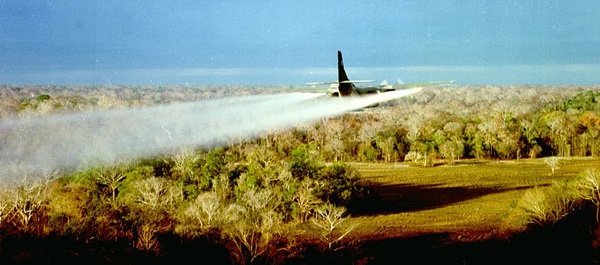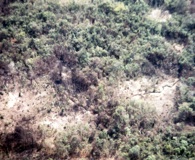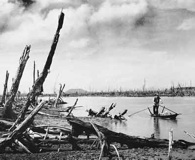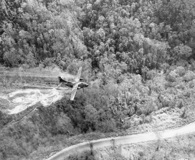Firestorm: Forest Fires as a Weapon in Vietnam

A UC123B spraying at low level during a Pink Rose operation in January 1967. Defoliation agents were sprayed twice, then covered with a drying agent. B-52s would drop cluster bombs to ignite the chemicals. The plan was to deny communist forces concealing cover, but the operations were not as successful as planners had hoped.U.S. Air Force photo.
The US military in Vietnam often seemed to view Mother Nature as being part of the enemy order of battle. Both the Viet Cong and People’s Army of Vietnam were experts in the use of camouflage and had an intimate knowledge of the terrain. As the United States steadily increased its direct involvement in the region, a major priority became tackling the enemy’s natural advantages. Hoping to defeat the guerrillas with the power of science and technology, few plans were seen as too outlandish to warrant some degree of investigation.
{default}The controversial herbicide program is perhaps the best known of the various attempts to try and reduce the natural cover provided by the jungle and other flora and expose enemy bases hidden inside. The herbicide-spraying operations, codenamed Trail Dust were split into two categories: defoliation and crop destruction. The US Air Force was among the services tasked with conducting these operations. The crews flying specially modified UC-123B and -123K aircraft were codenamed Ranch Hand. Defoliation missions consisted of spraying herbicides over known enemy base areas, as well as around roads, railroads, power lines, and other so-called "lines of communication." The spraying would remove the natural cover guerrillas used when conducting sabotage, ambushing convoys, or otherwise harassing friendly forces. Crop destruction was intended to reduce the ability of guerrillas to sustain themselves in their jungle hideouts.
The defoliation program is well known because of the herbicide codenamed Agent Orange, which contained the carcinogen dioxin. However, the US military made use of three major herbicides in Southeast Asia, the others being Agents White and Blue. Also tested were a rainbow of other types, with similar codenames like Agents Purple, Green, and Pink. While the differences between most types were in the exact blend and the specific ratios of the chemicals used, Agent Blue was a sodium salt of cacodylic acid, a desiccant not unlike that found in boxes of new shoes or electronics to keep them dry. Between 1962 and 1971, Ranch Hand crews, sprayed some 18 million gallons of herbicides over 20 percent of South Vietnam’s jungles and 36 percent of its mangrove forests.
 Though effective, Agent Orange, the fastest acting of all the herbicides, only began to show effects seven to ten days after the initial application. Maximum effectiveness was only achieved after four to six weeks. Additional spraying was expensive in time and resources, and South Vietnam’s climate, especially the rainy season, meant that herbicides were often ineffective. Rain would wash away the chemicals from their intended targets and drying out plants would be nearly impossible in the often-humid weather. Military Assistance Command, Vietnam (MACV) looked to speed up the process. One possibility was to find a method of harnessing the awesome power of forest fires, allowing US forces to generate firestorms on demand.
Though effective, Agent Orange, the fastest acting of all the herbicides, only began to show effects seven to ten days after the initial application. Maximum effectiveness was only achieved after four to six weeks. Additional spraying was expensive in time and resources, and South Vietnam’s climate, especially the rainy season, meant that herbicides were often ineffective. Rain would wash away the chemicals from their intended targets and drying out plants would be nearly impossible in the often-humid weather. Military Assistance Command, Vietnam (MACV) looked to speed up the process. One possibility was to find a method of harnessing the awesome power of forest fires, allowing US forces to generate firestorms on demand.
In early 1965, the first such operation was launched. Over 78 thousand gallons of herbicide were sprayed over a portion of the Bo Loi Forest west of Saigon over a four-week period from late January to early February. In the first week of March, the US Air Force launched Operation Sherwood Forest to ignite the forest using B-52 bombers dropping M35, also known as a "funny bomb," was an early type of cluster bomb dating back to the 1950s. Each M35 contained fifty-seven M74 incendiary bomblets, each filled with a little less than three pounds of "PT1." PT1 was an incendiary gel, consisting of a thickened fuel, containing magnesium, gasoline, and other petroleum products. Operation Sherwood Forest failed to spark a firestorm in the Bo Loi Forest, but did spark significant interest on the part of the US military in the potential use of forest fire as a weapon.
In December 1965, the Joint Chiefs of Staff requested that the Secretary of Defense perform a deeper investigation of how to destroy jungles and forests through the use of fire. This task was subsequently passed to the Advanced Research Projects Agency (ARPA). This type of project was not uncommon for APRA. Now called the Defense Advanced Research Projects Agency (DARPA), this organization is referred to sometimes as being the "mad scientists" of the Department of Defense because of the work it does.
In 1966, APRA initiated Project EMOTE (Environmental Modification Techniques) in cooperation with the US Forest Service, which had conducted intensive research into forest fires to help prevent them in the United States. Part of the research had involved gathering data on contributing factors that caused fires to start spontaneously. "Forest fuels" technicians were tasked with trying to see if these factors were present or could be artificially created in order to deliberately start them in Vietnam.
 By the end of January 1966, planning had begun on Operation Hot Tip, the first structured test of using fire to burn away natural cover. MACV suggested the Chu Pong Mountain area in Pleiku province as the target. The target would again be treated with defoliants prior to the strike. The Commander in Chief of US Pacific Command suggested using the BLU-29/B incendiary bomb, but the decision in the end was made to continue using the M35 cluster bomb, because of its availability. In March 1966, Strategic Air Command B-52s dropped one hundred and seventy-two M35s over the target area in two missions, Hot Tip I and Hot Tip II. The operation itself went off without a hitch, but no significant fires were observed over the target and no self-sustaining firestorm developed as had been hoped. However, vertical visibility over the target improved and the program continued.
By the end of January 1966, planning had begun on Operation Hot Tip, the first structured test of using fire to burn away natural cover. MACV suggested the Chu Pong Mountain area in Pleiku province as the target. The target would again be treated with defoliants prior to the strike. The Commander in Chief of US Pacific Command suggested using the BLU-29/B incendiary bomb, but the decision in the end was made to continue using the M35 cluster bomb, because of its availability. In March 1966, Strategic Air Command B-52s dropped one hundred and seventy-two M35s over the target area in two missions, Hot Tip I and Hot Tip II. The operation itself went off without a hitch, but no significant fires were observed over the target and no self-sustaining firestorm developed as had been hoped. However, vertical visibility over the target improved and the program continued.
Following Hot Tip, the codename Pink Rose was assigned to all jungle-burning operations in Vietnam. In June 1966, a set of formal guidelines for such missions were published. The Forest Service was busy conducting laboratory tests of "fuels" found in Southeast Asia to develop criteria for expected results. The Forest Service had already created a similar set of data for the United States. By late 1966, MACV decided that the War Zone C and D areas in the III Corps Tactical Zone would be the site of the Pink Rose tests. As in Hot Tip, target areas would be sprayed with defoliants followed by massive air strikes with incendiaries. Operation Attleboro, conducted by ground forces in War Zone C, uncovered significant enemy activity and delayed the first Pink Rose missions. The focus was shifted to War Zone D, and Pink Rose I was conducted in January 1967. Again, firestorms failed to occur. Pink Rose II and III, conducted later in January and in April 1967 were no more successful. The US Forest Service advised against further exploration, having come to the conclusion that in Southeast Asia it was highly unlikely that a self-sustaining firestorm could be generated without the weather and other environmental factors being perfectly aligned. In spite of these recommendations, the Forest Service was directed to continue its research. In 1970, they published their final report, having arrived at the same conclusions as before.
During this period, however, two jungle-burning operations were conducted. In April 1968, a forest fire raged in the U Minh Forest, a known enemy sanctuary. The fire, later reported to have been deliberately set by local fishermen upset over having to pay off Viet Cong and PAVN "tax collectors," reportedly devastated enemy bases inside the forest. During the fire, numerous secondary explosions were observed. The Commander in Chief of US Pacific Command asked MACV whether it would be possible to recreate the U Minh fire. MACV, with the information collected from Sherwood Forest, Hot Tip, and Pink Rose, said that the U Minh Forest, much of it flooded at high tide, would not be conducive to such operations.
 Again, in spite of the reservations, Operation Inferno was launched over the U Minh Forest. The plan differed dramatically from the previous method of spraying defoliants and then attacking the areas with incendiaries. In each of the four strikes, a snaking line of fourteen C-130s flew over the target area dropping 55-gallon drums of fuel oil. With the aircraft flying at an altitude of 3,000 feet, a total of 64 drums would be dropped over the forest. In the first mission on April 7th, 1968, a forward air controller ignited the fuel using white phosphorus rockets. On the other three missions, white phosphorus grenades were attached to the pallets with the fuel drums to ignite them. This created intense fires where the pallets had landed, but again after the fuel was consumed, the fires died out.
Again, in spite of the reservations, Operation Inferno was launched over the U Minh Forest. The plan differed dramatically from the previous method of spraying defoliants and then attacking the areas with incendiaries. In each of the four strikes, a snaking line of fourteen C-130s flew over the target area dropping 55-gallon drums of fuel oil. With the aircraft flying at an altitude of 3,000 feet, a total of 64 drums would be dropped over the forest. In the first mission on April 7th, 1968, a forward air controller ignited the fuel using white phosphorus rockets. On the other three missions, white phosphorus grenades were attached to the pallets with the fuel drums to ignite them. This created intense fires where the pallets had landed, but again after the fuel was consumed, the fires died out.
The final jungle-burning operation, Operation Banish Beach, was conducted in the summer of 1968 and led to the same conclusions as before: The ability to create a devastating self-sustaining firestorm required such a perfect conflagration of events as to be essentially impossible to artificially create. The actual results could not warrant the use of important resources. Unable to create the perfect storm, the program was shelved indefinitely, becoming just another obscure element of the air war in Southeast Asia.
About the Author
Joseph Trevithick is a Research Associate at GlobalSecurity.org and a historical consultant for Ambush Alley Games. He co-authored Ambush Valley: Vietnam 1965–1975, which was published in October 2011 by Osprey Publishing.


0 Comments
Trackbacks/Pingbacks